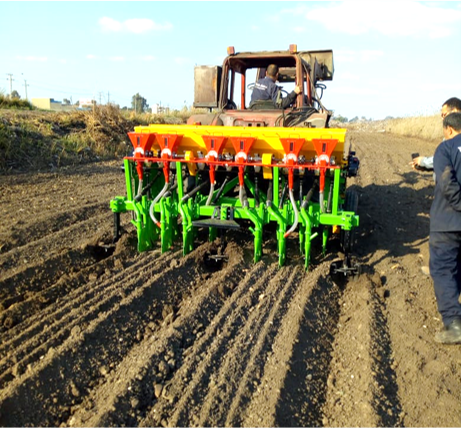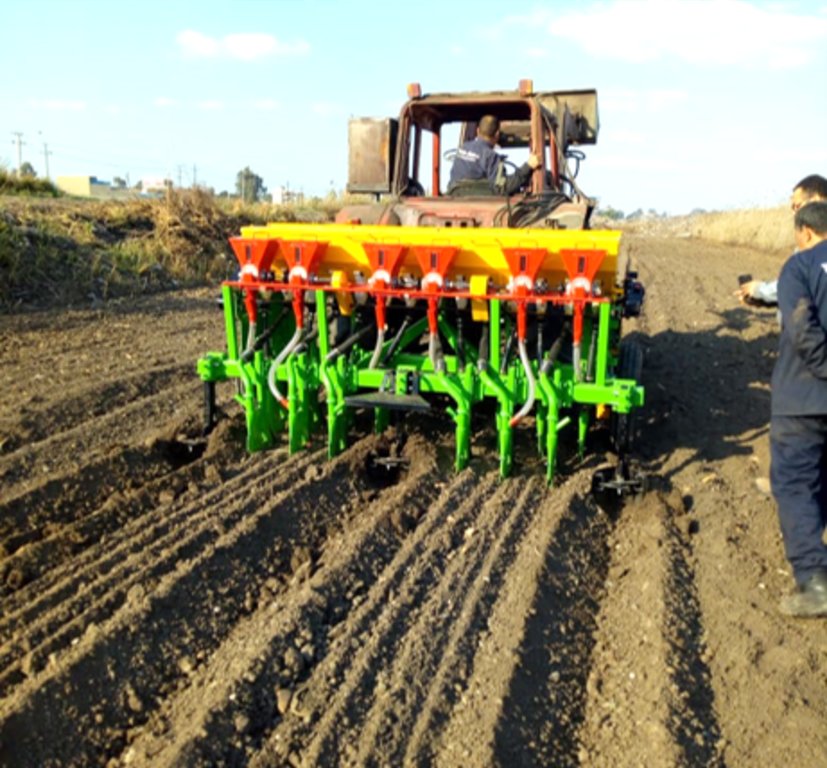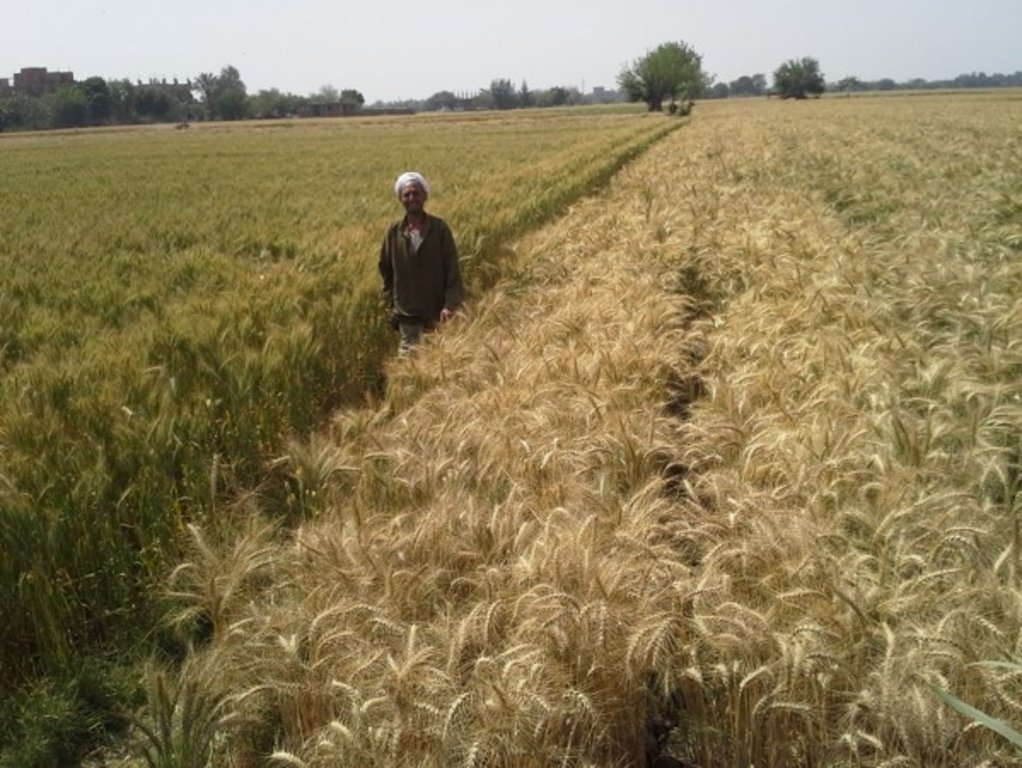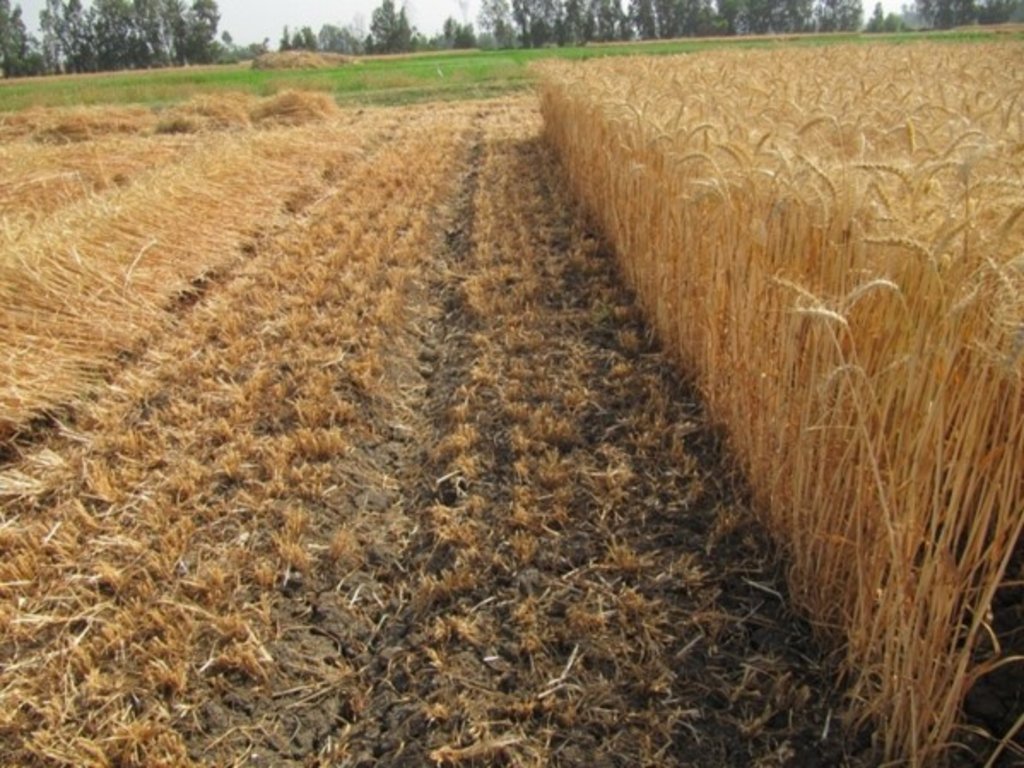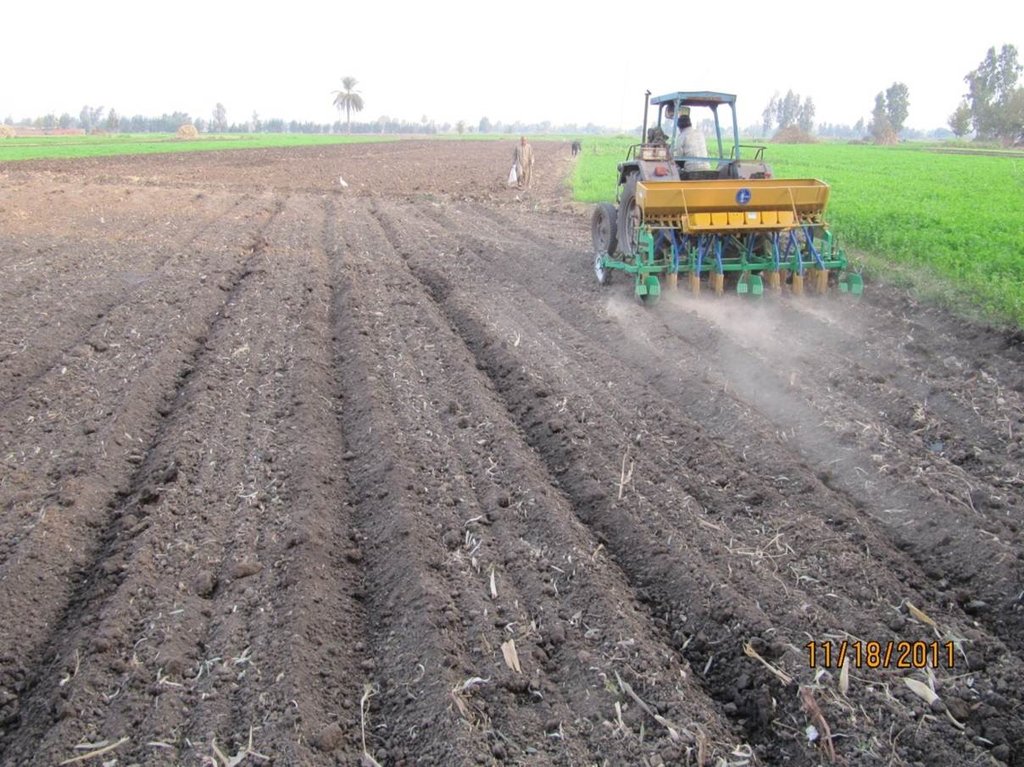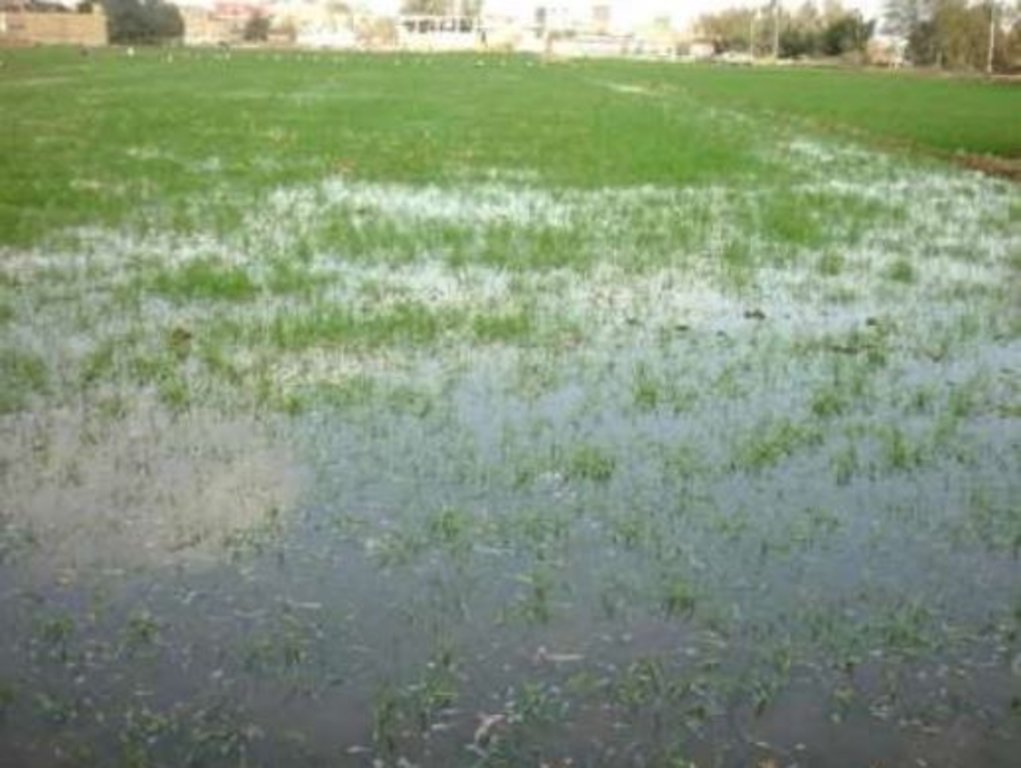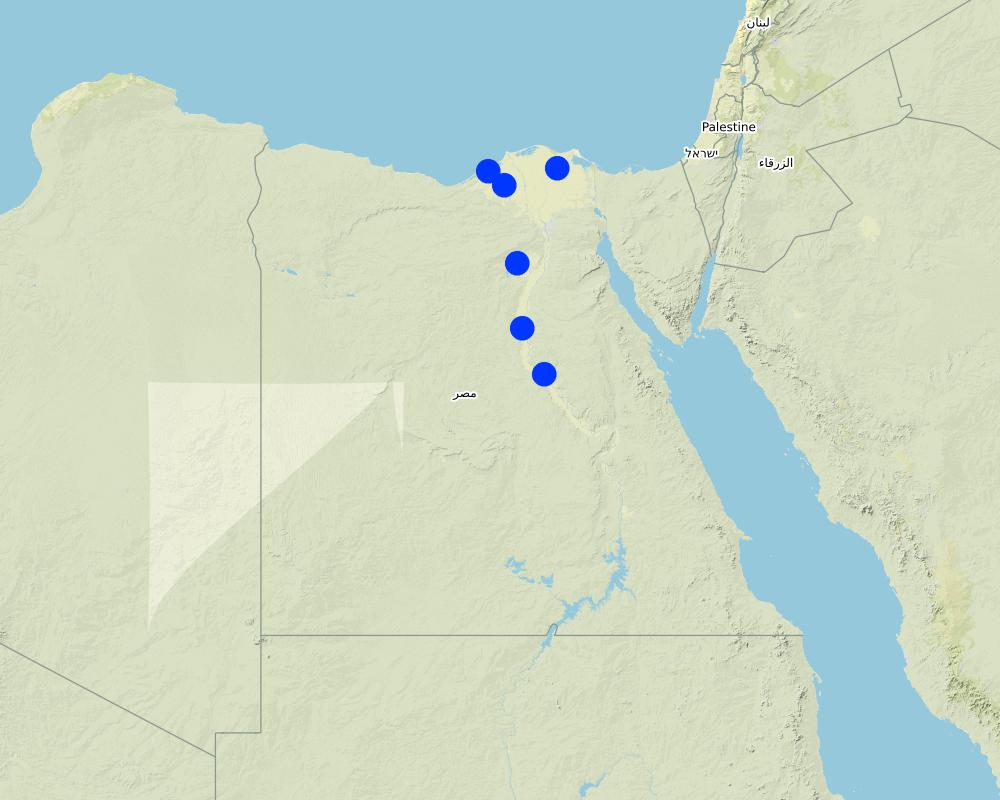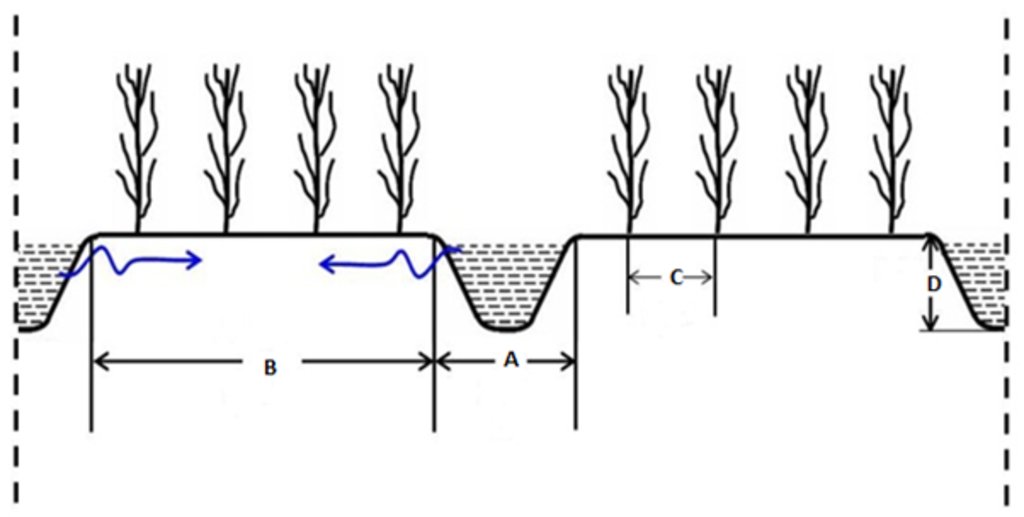Mechanized Raised Bed (MRB) Technology in a wheat based production system. [مصر]
- تاريخ الإنشاء:
- تحديث:
- جامع المعلومات: Joren Verbist
- المحرر: –
- المُراجع: Rima Mekdaschi Studer
technologies_5804 - مصر
عرض الأقسام
توسيع الكل طي الكل1. معلومات عامة
1.2 تفاصيل الاتصال بالأشخاص الرئيسيين لمصدر المعلومات والمؤسسات المشاركة في تقييم وتوثيق التقنية
الشخص (الأشخاص) الرئيسي لمصدر المعلومات
Senior Scientist, Irrigation Water Management:
Swelam Atef
International Center of Agriculture Research in the Dry Areas (ICARDA)
مصر
Social Sciences Specialist (Water Land and Ecosystem Program):
Dessalegn Bezaiet
International Center of Agriculture Research in the Dry Areas (ICARDA)
الأردن
اسم المشروع الذي سهّل توثيق/تقييم التقنية (إذا كان ذلك على صلة)
ICARDA Institutional Knowledge Management Initiativeاسم المؤسسة (المؤسسات) التي سهلت توثيق/تقييم التقنية (إذا كان ذلك على صلة)
International Center for Agricultural Research in the Dry Areas (ICARDA) - لبنان1.3 الشروط المتعلقة باستخدام البيانات الموثقة من خلال WOCAT
يوافق جامع المعلومات والشخص (لاشخاص) الرئيسي لمصدر المعلومات على الشروط المتعلقة باستخدام البيانات الموثقة من خلال WOCAT:
نعم
1.4 إعلان بشأن استدامة التقنية الموصوفة
هل التقنية الموصوفة هنا تمثل مشكلة فيما يتعلق بتدهور الأراضي، بحيث لا يمكن إعلانها تقنية مستدامة لإدارة الأراضي؟:
كلا
2. وصف تقنيةالإدارة المستدامي للأراضي
2.1 وصف مختصر للتقنية
تعريف التقنية:
Mechanized Raised Beds (MRB)-technology improves livelihoods because raised beds lead to significantly reduced costs (30% less water, 20-40% less nitrogen fertilizer) and higher wheat yields increased by 20-30%. MRB-technology helps to do more with less.
2.2 وصف تفصيلي للتقنية
الوصف:
Mechanized Raised Beds (MRB)-technology has been applied by the International Centre of Agriculture Research in Dryland Areas (ICARDA) and national partners in Egypt. Egypt is a water scarce country and 95% of its water comes from beyond its borders. In addition, Egypt is highly dependent on the import of wheat, 50% of the wheat demand is met by import.
In Egypt, water scarcity and mediocre yield are two issues that keep the majority of people working in the agricultural sector in poverty. Water is scarce as the annual precipitation is less than 250mm leading to most farming to be irrigated. The water comes from the Nile river. However, available irrigation water per farmer is rather low due to population growth. Thus, due to clay soil and the use of flood irrigation, water logging and uneven water distribution over the field lead to salinization of the soil, harming the farmer's yields. Furthermore, the latter is caused by the lack of water, insufficient use of fertilizers and the use of relatively low-quality seeds. In particular, fertilizers are expensive leading to an insufficient and poor application of fertilizers.
In effect, the core objective of MRB-technology package is to fit within this context and realize more output with less input, consequently improving involved livelihoods. Indeed, MRB improves farmers' resilience with increased water and nutrient efficiency. The adopters of MRB receive benefits from direct effects such as improvement in their livelihoods, a decreased workload, increased yields and more efficient use of resources (water, fertilizer and seeds).
The first stage research and designing of MRB-technology was done in 2003. Introductions and pilots of the technology were designed together with regular farmers in the Nile Delta-area, from 2010 until 2013. In 2015, MRB-technology was proven beneficial permitting out-scaling. Thanks to the shown potential of MRB-technology and Egypt's reliance on foreign countries for water and wheat, that MRB-technology has become a strong component of Egypt's national wheat campaign. The Egyptian Government aims to cultivate 2 million acres of wheat under MRB-technology, by 2022.
MRB-technology raises the seedbed simultaneously seeding wheat, consequently creating furrows, of which the length depend on the dimensions of the farm- field. The inter- furrow spacing and the width depends on the type of crop planted and on the soil type. The field/terrain may not exceed a slope of 5%. This allows water to infiltrate, reach the end of the furrow and for safe run-off, preventing water-logging. So, to implement MRB-technology, the field might be levelled prior to implementation, but this is often not the case as MRB is designed to local conditions, and most fields already have a slope of less than 5%. The practice of the machine requires a loose soil, so it is required that the field is ploughed prior to seeding, and therefore MRB is not seen as a type of ploughing. If the field preparation is done, a MRB-machine can start seeding and raising the seedbed. Specific characteristics for MRB-technology with respect to conventional seeding, is that seeding and raising seedbeds are done simultaneously. Raising seedbeds mechanically saves 80% of the workload with respect to manually raising seedbeds. The after-harvest practice depends on the farmer preference, as some farmers prefer letting the stubble grazed, while others clear the field. The after-harvest practices are thus independent with respect to MRB.
In addition, to complement the Mechanized Raised Bed, High Quality Seeds are offered. These are beneficial as they yield higher than the regular wheat seeds. Nevertheless, the machine can also be practiced with regular wheat seeds, if the high-quality seeds are found too expensive by the farmer. The High Quality Sees are hybrid, and need to be replaced after three years to ensure high quality.
The technology has significant positive impacts for local farmers as applied water is saved by 25%, water pumping costs decreased by 25%, seed rate reduced by 50%, farming costs decreased by 30%, fertilizer use efficiency increased by 30%, and crop yield increased by 15-30% with respect to conventional farming. On overall, it is estimated that farming under MRB is about 1/3 of the cost with respect to conventional farming. Manually raising seedbeds was considered too expensive due to the required amount of labour. Thus, regular flood irrigation was practiced. Practically, this results in full surface flooding of the field. This has significantly higher evaporation hence increasing salinization, as opposed to furrow irrigation through raised seedbeds. Also, because water is well distributed over the field due to the furrows (reducing water stress and water logging), there is less leaching of the nutrient hence increased nutrient-efficiency. The raised seedbeds allow excess water, in case of a heavy rainfall event or over-irrigating, to safely run-off. These features of better water disposal and reduced evaporation makes MRB-technology well suited with respect to climate change, which leads to more concentrated rainfall events and increased temperature hence increased evaporation. In addition, as MRB prevents e.g. waterlogging it prevents land degradation (e.g. salinization).
Therefore, livelihoods of farmers who have adopted this technology have been greatly improved. Farmers who have adopted MRB, agree that MRB is affordable, easy to apply, improves production and is cost saving. Furthermore, since this technology increases irrigation efficiency , it can mitigate existing upstream-downstream issues in terms of availability, as there is more available irrigation water. Also, as MRB-technology is currently out scaled, it creates employment opportunities since MRB-machines are locally produced from scratch.
2.3 صور التقنية
2.4 فيديوهات عن التقنية
تعليقات، وصف موجز:
https://www.youtube.com/watch?v=5SW_Hf5AM3Y
اسم مصور الفيديو:
ICARDA
2.5 البلد/المنطقة/المواقع التي تم تنفيذ التقنية فيها والتي يغطيها هذا التقييم
البلد:
مصر
المنطقة/الولاية/المحافظة:
Sharkia, Dakahlia, Beheira, Fayoum, Minya and Asuit
حدد انتشار التقنية:
- منتشرة بالتساوي على مساحة
إذا كانت المساحة الدقيقة غير معروفة، فيرجى الإشارة إلى المنطقة التقريبية المغطاة:
- 10-1 كم2
هل يقع موقع/مواقع التقنية في منطقة محمية بشكل دائم؟:
كلا
Map
×2.6 تاريخ التنفيذ
اذكر سنة التنفيذ:
2003
2.7 إدخال التقنية
حدد كيف تم إدخال التقنية:
- أثناء التجارب/الأبحاث
- من خلال المشاريع/ التدخلات الخارجية
3. تصنيف تقنية الإدارة المستدامي للأراضي
3.1 الغرض الرئيسي ( الأغراض الرئيسية) للتقنية
- تحسين الإنتاج
- الحد من تدهور الأراضي ومنعه وعكسه
- التكيف مع تغير المناخ/الظواهر المتطرفة وآثارها
- خلق أثر اقتصادي مفيد
- خلق أثر اجتماعي مفيد
3.2 نوع (أنواع) استخدام الأراضي الحالية حيث يتم تطبيق التقنية
استخدامات الأراضي مختلطة ضمن نفس وحدة الأرض:
كلا

الأراضي الزراعية
- زراعة سنوية
الزراعة السنوية - حدد المحاصيل:
- الحبوب - قمح (شتوي)
عدد مواسم الزراعة في السنة:
- 1
هل يتم ممارسة الزراعة البينية؟:
كلا
هل تتم ممارسة تناوب المحاصيل؟:
كلا
3.3 هل تغير استخدام الأراضي نتيجة لتنفيذ التقنية؟
هل تغير استخدام الأراضي نتيجة لتنفيذ التقنية؟:
- لا (تابع مع السؤال 3.4)
3.4 إمدادات المياه
إمدادات المياه للأرض التي يتم تنفيذ التقنية عليها:
- ري كامل
التعليقات:
The farms are irrigated from water that comes from the Nile river.
3.5 مجموعةالإدارة المستدامة للأراضي التي تنتمي إليها هذه التقنية
- تحسين أصناف النباتات/سلالات الحيوانات
- إدارة الري (بما في ذلك إمدادات المياه والصرف الصحي)
3.6 التدابير التقنية في مجال إلادارة المستدامة للأراضي

التدابير الزراعية
- A3: معالجة سطح التربة
- A5: إدارة البذور، الأصناف المحسنة

التدابير البنيوية
- S3: الخنادق المتدرجة ،والقنوات، والممرات المائية
التعليقات:
Ploughing is required to allow for raising seedbeds mechanically. Nevertheless, ploughing was also done in conventional farming. As seedbeds are raised whenever wheat is sown, this is recurrent so ploughing is as well.
3.7 الأنواع الرئيسية من تدهور الأراضي التي تناولتها التقنية

التدهور الكيميائي للتربة
- (Cs): التملح/ القلونة

التدهور المادي أو الفيزيائي للتربة
- (Pw): تشبع التربة بالمياه

التدهور البيولوجي
- (Bq): انخفاض الكمية/الكتلة الحيوية

تدهور المياه
- (Ha): التجفيف
التعليقات:
Due to degradation the biomass production decrease. MRB-technology increase safe water disposal and decreased evaporation. This results in the prevention of water logging and a decrease in the rate of salinization and aridfication.
3.8 منع أو حد أو عكس تدهور الأراضي
تحديد هدف التقنية فيما يتعلق بتدهور الأراضي:
- منع تدهور الأراضي
4. المواصفات الفنية، وأنشطة التنفيذ، والمدخلات، والتكاليف
4.1 الرسم الفني للتقنية
المواصفات الفنية (المتعلقة بالرسم الفني):
Firstly, prior to Mechanized Raised Seedbed (MRB)-implementation the field is prepared. This consist of two-way ploughing. This makes the soil sufficiently loose, to enable the practice of MRB i.e. construction of the raised seedbeds. Also, for successful implementation of the MRB, the field should have a slope of less than 5%.
Secondly, the raised bed seeder is pulled by a tractor and raises the seed bed while seeding wheat, hence Mechanized Raised Seedbed technology. The width of the furrow (A) is 35 -45 cm, this is affected by the related soil texture. The width of the raised seedbed (B) is 100-130 cm, also dependent on the soil texture. Between
seed rows (C) there is a space of 14 cm.This inter-row spacing of the crops relates to the type of crop seeded. The furrow has a depth (D) of 35-45 cm. However, after the first irrigation event the depth could be reduced to 25 cm, due to the influx of loose soil. This is not a problem for the current growing season.
This technical drawing is based on the most common conditions where MRB is implemented. These are that the crop is winter wheat, the soil texture is mostly clay and the system is watered through irrigation coming from the Nile river, rather than rain-fed. If MRB is used under different circumstances, the dimension would change as well.
Lastly, once these above-mentioned steps are successfully done, the agricultural practices do not differ from the previous/traditional method. After harvest, prior to the new season, the raised seedbed structures are still well in shape. This means that after some small reshaping, the raised seedbeds can be used for cultivation again, without using MRB and/or the previously mentioned field preparation. This reshaping is done by cleaning/digging out the furrows. Additionally, this reduces the consequences of compaction by heavy machinery, such as the tractor. As these heavy machinery are used less frequently.
المؤلف:
Joren Verbist (Drawing: Atef Swelam)
التاريخ:
30/09/2020
4.2 معلومات عامة بخصوص حساب المدخلات والتكاليف
حدد كيفية احتساب التكاليف والمدخلات:
- حسب مساحة تنفيذ التقنية
الإشارة إلى حجم ووحدة المساحة:
1 acre
في حالة استخدام وحدة مساحة محلية، قم بالإشارة إلى عامل التحويل إلى هكتار واحد (على سبيل المثال، 1 هكتار = 2.47 فدان): 1 هكتار =:
2.47 acres
حدد العملة المستخدمة لحساب التكاليف:
- دولار أمريكي USD
اذكر متوسط تكلفة أجر العمالة المستأجرة في اليوم الواحد:
6.31
4.3 أنشطة التأسيس
| النشاط | التوقيت (الموسم) | |
|---|---|---|
| 1. | Purchase MRB |
4.4 التكاليف والمدخلات اللازمة للتأسيس
| تحديد المدخلات | الوحدة | الكمية | التكاليف لكل وحدة | إجمالي التكاليف لكل مدخل | % من التكاليف التي يتحملها مستخدمو الأراضي | |
|---|---|---|---|---|---|---|
| معدات | MRB-Machine | Machine | 1,0 | 6000,0 | 6000,0 | 100,0 |
| إجمالي تكاليف إنشاء التقنية | 6000,0 | |||||
| إجمالي تكاليف إنشاء التقنية بالدولار الأمريكي | 6000,0 | |||||
التعليقات:
The total costs per acre are estimated to be 44 USD to 64 USD for solely a MRB-machine, so the costs of the High Yield Seeds are excluded.
The purchase of a MRB-machine is commonly done by a community (such as a village). Therefore the realistic costs per farmer of the machine are rather low, as well as the cost per area. The tractor which is used to pull a MRB-machine is the same as has been used before the adoption of a MRB, so this is not an additional cost
The High Yield Seeds are offered with a MRB-machine, but a MRB-machine is build that it can use other seeds as well.
4.5 الصيانة/الأنشطة المتكررة
| النشاط | التوقيت/الوتيرة | |
|---|---|---|
| 1. | Ploughing | Prior to seeding |
| 2. | Levelling (if needed) | Prior to seeding |
| 3. | Seeding/Raising seedbeds (i.e. use of MRB) | November |
| 4. | Irrigation Event (300-400m3) | Once in every 25-30 days |
| 5. | Fertilizer Application | Establishment Stage (November) |
| 6. | Fertilizer Application | Flowering Stage (March-May) |
| 7. | Fertilizer Application | Grain Filling Stage (June-July) |
| 8. | Harvesting | April |
| 9. | Purchase new High Yield Seeds | Once in the 3 years |
التعليقات:
MRB-machines are produced by local manufactures. This means that repairs could be done relatively cheap and on time.
The cleaning of the furrows can be done by the farmers self. Therefore, it is not a significant cost.
4.6 التكاليف والمدخلات اللازمة للصيانة/للأنشطة المتكررة (سنويًا)
| تحديد المدخلات | الوحدة | الكمية | التكاليف لكل وحدة | إجمالي التكاليف لكل مدخل | % من التكاليف التي يتحملها مستخدمو الأراضي | |
|---|---|---|---|---|---|---|
| العمالة | Pesticide and herbicide application | Person-Day | 2,0 | 6,0 | 12,0 | 100,0 |
| العمالة | Field Preparation and Raising Seedbeds | Person-Day | 2,0 | 100,0 | ||
| العمالة | Fertilizer Application | Person-Day | 1,0 | 7,0 | 7,0 | 100,0 |
| العمالة | Irrigation Management | Person-Day | 5,0 | 7,0 | 35,0 | 100,0 |
| معدات | Combine (harvesting) | Machine Day | 1,0 | 64,0 | 64,0 | 100,0 |
| معدات | MRB | Machine-Day | 1,0 | 10,0 | 10,0 | 100,0 |
| معدات | Tractor (Raising Seedbed) | Machine-Day | 1,0 | 17,0 | 17,0 | 100,0 |
| معدات | Sprayer | Machine-Day | 1,0 | 20,0 | 20,0 | 100,0 |
| معدات | Plough | Machine-Day | 1,0 | 32,0 | 32,0 | 100,0 |
| معدات | Tractor (Field Preparation) | Machine-Day | 1,0 | 32,0 | 32,0 | 100,0 |
| المواد النباتية | High Yield Seeds | Kilogram | 45,0 | 0,6 | 27,0 | 100,0 |
| الأسمدة والمبيدات الحيوية | Fertilizer | Kilogram | 150,0 | 0,26 | 39,0 | 100,0 |
| الأسمدة والمبيدات الحيوية | Herbicide | Kilogram | 1,0 | 9,5 | 9,5 | 100,0 |
| الأسمدة والمبيدات الحيوية | Pesticide | Kilogram | 2,0 | 7,0 | 14,0 | 100,0 |
| مواد البناء | Water (Irrigation Event) | 350m^3 | 20,0 | 8,0 | 160,0 | 100,0 |
| غير ذلك | Harvesting | Person-Day | 5,0 | 7,0 | 35,0 | 100,0 |
| غير ذلك | Maintenance Raised Seedbed | Person-Day | 8,0 | 7,0 | 56,0 | 100,0 |
| إجمالي تكاليف صيانة التقنية | 569,5 | |||||
| إجمالي تكاليف صيانة التقنية بالدولار الأمريكي | 569,5 | |||||
التعليقات:
The pumping cost is 25% less with respect to the conventional flood irrigation.
4.7 أهم العوامل المؤثرة على التكاليف
قدم وصفا لأهم العوامل التي تؤثر على التكاليف:
The most impacting cost factor is the purchase of a MRB-machine. Whereas, the High Yield Seeds are also significant, but the increased yield justifies this. In addition, farmers could also choose to use different seeds. Additionally, the High Yield Seeds are hybrid and can be reproduced for three years on the farm.
5. البيئة الطبيعية والبشرية
5.1 المناخ
هطول الأمطار السنوي
- < 250 مم
- 251- 500 ملم
- 501 - 750ملم
- 1,000-751 ملم
- 1,500-1,100 ملم
- 2,000-1,500 ملم
- 3,000-2,001 ملم
- 4,000-3,100 ملم
- > 4000 ملم
المواصفات/التعليقات على هطول الأمطار:
The annual rainfall varies between 20mm and 200mm
Egypt is characterized as a hot desert climate (Köppen climate classification BWh). The hot season is from May to October. While the cool season is opposite, from October to May.
المنطقة المناخية الزراعية
- شبه قاحلة
- قاحلة
Egypt is characterized as a hot desert climate (Köppen climate classification BWh). The hot season is from May to October. While the cool season is oppesite, from October to May.
5.2 طوبوغرافيا
متوسط الانحدارات:
- مسطح (0-2%)
- بسيط (3-5%)
- معتدل (6-10%)
- متدحرج (11-15%)
- تلال (16-30%)
- شديدة الانحدار(31-60%)
- فائقة الانحدار (>60%)
التضاريس:
- هضاب/سهول
- أثلام مرتفعة
- المنحدرات الجبلية
- منحدرات التلال
- منحدرات في السفوح
- قاع الوادي
المنطقة الارتفاعية:
- 100-0 متر فوق سطح البحر
- 500-101 متر فوق سطح البحر
- 1,000-501 متر فوق سطح البحر
- 1,500-1,001 متر فوق سطح البحر
- 2,000-1,501 متر فوق سطح البحر
- 2,500-2,100 متر فوق سطح البحر
- 3,000-2,501 متر فوق سطح البحر
- 4,000-3,001 متر فوق سطح البحر
- > 4000 متر فوق سطح البحر
وضح ما إذا كانت التقنية مطبقة على وجه التحديد في:
- حالات محدبة أو نتؤات
5.3 التربة
متوسط عمق التربة:
- ضحل جدًا (0-20 سم)
- ضحلة (21-50 سم)
- متوسطة العمق (51-80 سم)
- عميقة (81-120 سم)
- عميقة جدًا (> 120 سم)
قوام التربة (التربة السطحية):
- متوسط ( طميي، سلتي)
- ناعم/ثقيل (طيني)
قوام التربة (> 20 سم تحت السطح):
- متوسط ( طميي، سلتي)
- ناعم/ثقيل (طيني)
المواد العضوية في التربة السطحية:
- متوسطة (1-3%)
- منخفضة (<1%)
5.4 توافر المياه ونوعيتها
منسوب المياه الجوفية:
< 5 م
توافر المياه السطحية:
جيد
نوعية المياه (غير المعالجة):
مياه الشرب سيئة (تتطلب معالجة)
تشير جودة المياه إلى:
المياه السطحية
هل تعتبر ملوحة الماء مشكلة؟:
نعم
هل تحدث فيضانات في المنطقة؟:
نعم
الإنتظام:
بشكل عرضي
5.5 التنوع البيولوجي
تنوع الأنواع:
- منخفض
تنوع الموائل:
- منخفض
5.6 خصائص مستخدمي الأراضي الذين يطبقون التقنية
مستقر أو مرتحل:
- غير المترحل
التوجه السوقي لنظام الإنتاج:
- مختلط (كفاف/ تجاري)
الدخل من خارج المزرعة:
- 10-50% من جميع الإيرادات
المستوى النسبي للثروة:
- ضعيف
أفراداً أو مجموعات:
- المجموعات/ المجتمع المحلي
مستوى المكننة:
- ميكانيكية/ مزودة بمحرك
الجنس:
- نساء
- رجال
عمر مستخدمي الأرضي:
- متوسط العمر
- كبار السن
5.7 متوسط مساحة الأرض التي يستخدمها مستخدمو الأراضي الذين يطبقون التقنية
- < 0.5 هكتارا
- 0.5 - 1 هكتار
- 1 -2 هكتار
- 2 - 5 هكتار
- 5 - 15 هكتار
- 15 - 50 هكتار
- 50 - 100هكتار
- 500-100 هكتار
- 1,000-500 هكتار
- 10,000-1,000 هكتار
- > 10,000 هكتار
هل يعتبر هذا نطاقًا صغيرًا أو متوسطًا أو واسعا (في إشارة إلى السياق المحلي)؟:
- على نطاق صغير
التعليقات:
However, it is hard to generalize, since the MRB has been used on such a scale, including many different farms and sizes.
5.8 ملكية الأراضي، وحقوق استخدام الأراضي، وحقوق استخدام المياه
ملكية الارض:
- فردية، يوجد سند ملكية
حقوق استخدام الأراضي:
- فردي
حقوق استخدام المياه:
- فردي
هل تعتمد حقوق استخدام الأراضي على نظام قانوني تقليدي؟:
نعم
حدد:
Land use right are formed by Islamic influences as well as colonial influences. The are different status such as private ownership and open acces.
5.9 الوصول إلى الخدمات والبنية التحتية
الصحة:
- ضعيف
- معتدل
- جيد
التعليم:
- ضعيف
- معتدل
- جيد
المساعدة التقنية:
- ضعيف
- معتدل
- جيد
العمل (على سبيل المثال خارج المزرعة):
- ضعيف
- معتدل
- جيد
الأسواق:
- ضعيف
- معتدل
- جيد
الطاقة:
- ضعيف
- معتدل
- جيد
الطرق والنقل:
- ضعيف
- معتدل
- جيد
مياه الشرب وخدمات الصرف الصحي:
- ضعيف
- معتدل
- جيد
الخدمات المالية:
- ضعيف
- معتدل
- جيد
التعليقات:
In the Nile Delta, the MRB-technology is used on very large area with many different farmers, therefore it is hard to generalize the aspects of the Health and Education since these are highly related to the income of a farm.
6. الآثار والتصريحات الختامية
6.1 الآثار التي أظهرتها التقنية في الموقع
الآثار الاجتماعية والاقتصادية
الإنتاج
إنتاج المحاصيل
الكمية بعد الإدارة المستدامة للأراضي:
+20%-30%
التعليقات/ حدد:
The yield is increased due to reduced water stress and because of the use of improved wheat varieties.
جودة المحاصيل
التعليقات/ حدد:
The quality of the crops is increased due to reduced water stress.
خطر فشل الإنتاج
التعليقات/ حدد:
This decrease as the impact of intense rainfall events is reduced as consequence of safe disposal through furrows.
توافر المياه ونوعيتها
الطلب على مياه الري
التعليقات/ حدد:
The demand of irrigation water is reduced because the efficiency of it is increased i.e. water is applied more effectively.
الدخل والتكاليف
النفقات على المدخلات الزراعية
التعليقات/ حدد:
50% less seed rate. 20% higher fertilizer efficiency.
دخل المزرعة
التعليقات/ حدد:
Because of higher yield and less input
عبء العمل
التعليقات/ حدد:
The workload was reduced by 80% for mechanized seedbed raising (MRB) compared to manual seedbed raising.
الآثار الاجتماعية والثقافية
التخفيف من حدة الصراع
التعليقات/ حدد:
Because the irrigation efficiency is increased, there is relatively more available irrigation water. This leads to a mitigating effect on upstream/downstream tensions
الآثار الايكولوجية
دورة المياه / الجريان السطحي
الجريان السطحي
التعليقات/ حدد:
Run-off occurs more easily with respect to traditional practices. This is positive, since this prevent water-logging.
تصريف المياه الزائدة
التبخر
التعليقات/ حدد:
Compared to previous border/field irrigation, the water infiltrates easier, and is concentrated more. This leads to a decrease in evaporation.
التربة
رطوبة التربة
دورة المغذيات/إعادة الشحن
التعليقات/ حدد:
Due to better infiltration, the fertilizers are used more efficient.
الملوحة
التعليقات/ حدد:
Salinity is decreased because evaporation and water logging is reduced.
التنوع البيولوجي: الغطاء النباتي، الحيوانات
الكتلة الحيوية/ طبقة الكربون فوق التربة
الحد من مخاطر المناخ والكوارث
آثار الفيضانات
التعليقات/ حدد:
The impact of a flood is reduced because the excess water is able to safely run-off through the established furrows.
6.2 الآثار التي أظهرتها التقنية خارج الموقع
الفيضان في اتجاه مجرى النهر
التعليقات/ حدد:
Due to the increased irrigation water efficiency, there is relatively more water available to desirably flood (border/surface irrigation/ MRB) farm fields downstream
6.3 تعرض التقنية وحساسيتها لتغير المناخ التدريجي والظواهر المتطرفة/الكوارث المرتبطة بالمناخ (كما يراها مستخدمو الأراضي)
تغير مناخ تدريجي
تغير مناخ تدريجي
| الموسم | زيادة أو نقصان | كيف تتعامل التقنية مع ذلك؟ | |
|---|---|---|---|
| درجة الحرارة السنوية | زيادة | باعتدال | |
| هطول الأمطار السنوي | انخفاض | جيدا |
الظواهر المتطرفة / الكوارث المرتبطة بالمناخ
الكوارث الهيدرولوجية
| كيف تتعامل التقنية مع ذلك؟ | |
|---|---|
| فيضان عام (نهر) | جيدا |
| فيضان مفاجئ | جيدا |
6.4 تحليل التكلفة والعائد
كيف يمكن مقارنة العوائد نسبة لتكاليف الإنشاء (من وجهة نظر مستخدمي الأراضي)؟
عوائد قصيرة الأجل:
ايجابي جدا
عوائد طويلة الأجل:
ايجابي جدا
كيف تتم مقارنة العوائدمع كلفة الصيانة/التكاليف المتكررة (من وجهة نظر مستخدمي الأراضي)؟
عوائد قصيرة الأجل:
ايجابي جدا
عوائد طويلة الأجل:
إيجابي
التعليقات:
In the short-term investments are weighing relatively more than in the long term with respect to the benefits. However, on the overall, the MRB-technology offers more efficient use of resources, coming down to achieving more output with less input. Thus, highly improving the involved livelihoods.
In the long term the benefits are less positive with respect to maintenance. This is due to the aging of machinery. MRB-machines are estimated to have a life span of 12 years.
6.5 اعتماد التقنية
- > 50%
من بين جميع الذين تبنوا التقنية، كم عدد الذين فعلوا ذلك بشكل تلقائي، أي دون تلقي أي حوافز مادية/مدفوعات؟:
- 91-100%
6.6 التكيف
هل تم تعديل التقنية مؤخرًا لتتكيف مع الظروف المتغيرة؟:
نعم
أخرى (حدد):
Local Conditions
حدد تكيف التقنية(التصميم، المواد/الأنواع، الخ.):
These adaptations are initiated because of the successes of the MRB, so currently MRB-technology is modified to be used with other crops (e.g. Faba Bean), other soil textures and for rain-fed areas.
6.7 نقاط القوة / المزايا / الفرص التي توفرها التقنية
| نقاط القوة/ المزايا/ الفرص من وجهة نظر مستخدمي الأراضي |
|---|
| MRB significantly contributes to the prosperity of the farmers who have adopted this technology. For farmers, the major advantage of MRB (High Quality Seeds plus the raised seedbeds) is the increased yield. |
| The adoption of the technology leads eventually to less leaching hence higher fertilizer efficiency. This is also highly valued by the farmers as this translates into less expenses. This advantage of the MRB combined to the increased yield, results in the realization of more income with less expenses, and thus a higher net income. |
| In Egypt climate change is visibly present and water does not seem to be abundant anymore, the farmers do have increasingly attention for the value of water. MRB increases the irrigation efficiency, therefore this is also observed as a great advantage of MRB. |
| نقاط القوة/ المزايا/ الفرص من وجهة نظر جامع المعلومات أو غيره من الاشخاص الرئيسيين لمصدر المعلومات |
|---|
| The increased yield is of great advantage not only for the improved situation of the involved livelihood, but also on national level. Namely, because more yield means less import of food from other countries. This makes Egypt more self-sufficient, and less dependent on other countries. This is particularly relevant with respect to the significant population growth of Egypt. |
| The increased water availability, because of higher irrigation efficiency is important on a national level. This is certainly important, with respect to trend of increasing the power generation by water (hydraulic power plants), in upstream areas of Egypt. |
| MRB-technology has led to a local industry. This industry is the manufacturing of MRB-machines. This is on broader level beneficial, because it creates local employment, efficient supply chain, easy and fast access to technical knowledge and gives Egypt an independent position. |
| MRB improves soil health because salinization is reduced as water is less evaporated and logged. |
6.8 نقاط ضعف / مساوىء / مخاطر التقنية وسبل التغلب عليها
| نقاط الضعف/ المساوىء/ المخاطر من وجهة نظر مستخدم الأراضي | كيف يمكن التغلب عليها؟ |
|---|---|
| A current risk of MRB is that many farmers are convinced of the beneficial application of the MRB, which means that there is higher demand. Therefore, there is currently not a sufficient number of MRB-machines. In practice this means that some farmers are not able to use MRB-machine during the essential seeding period. This is possibly followed by tensions between users since the technology is often purchased as communities. Land users found this a weakness of the technology. | This is to overcome if public and private sectors invest in the manufacturing of MRB. This would lead to an increased supply of machine, thus eliminating the deficit of machines. |
| The cost of the High Yield Seeds is a weakness of MRB-technology. This is because the costs of the seeds are quite high and they contribute significantly to the increased yields. So without the seeds, MRB-technology does not reach its full potential. Farmers dislike the costs of these seeds and the yearly purchasing. | There are investments needed and plans to improve the production of these seeds. The increased supply would lead to reduced costs. |
| نقاط الضعف/ المساوىء/ المخاطر من وجهة نظر جامع المعلومات أو غيره من الاشخاص الرئيسيين لمصدر المعلومات | كيف يمكن التغلب عليها؟ |
|---|---|
| The risk of tensions that are a consequence of the limited availability of the MRB's. | This could be overcome by increasing the production. However, better social cooperation could reduce the tensions between and within communities as well. |
| The costs of the High Yield Seeds. This is a weakness, because MRB-technology is significantly improved by these seeds, realizing its full potential. | There are investments needed and plans to improve the production of these seeds. This would lead to reduced costs. However, alternatively, other seeds can be used. |
7. المراجع والروابط
7.1 طرق جمع/مصادر المعلومات
- مقابلات مع المتخصصين/الخبراء في الإدارة المستدامة للأراضي
- التجميع من التقارير والوثائق الأخرى الموجودة
7.2 المراجع للمنشورات المتاحة
العنوان، المؤلف، السنة، النظام القياسي الدولي لترقيم الكتب ISBN:
Atef Swelam and Y. Atta, (2012) Improve Water Saving and Water Productivity by New Approach of Farm Management under Surface Irrigation. Mi. J. Ag. Eng., 29 (2):745-762.
متاح من أين؟كم التكلفة؟:
https://hdl.handle.net/20.500.11766/12227
7.3 روابط للمعلومات ذات الصلة على الإنترنت
العنوان/الوصف:
Jeffrey Alwang, Samy Sabry, Kamel Shideed, Atef Swelam and Habib Halila (2017) Economic and food security benefits associated with raised-bed wheat production in Egypt, Journal of Food Security, FOSE-D-17-00372)
عنوان الرابط URL:
https://hdl.handle.net/20.500.11766/8228
العنوان/الوصف:
Atef Swelam (2016) Science Impact: Raised-bed planting in Egypt: an affordable technology to rationalize water use and enhance water productivity, Issue: 6-FEB 2016, ICARDA.
عنوان الرابط URL:
https://hdl.handle.net/20.500.11766/5900
العنوان/الوصف:
National Wheat Campaign Report (2020), Agricultural Research Center, Ministry of Agriculture and Land Reclamation, Cairo, Egypt
عنوان الرابط URL:
https://hdl.handle.net/20.500.11766/8228
العنوان/الوصف:
Karrou, M., T. Oweis, B. Benli and A. Swelam (2012). Improving Water and Land Productivities in Irrigated Systems, ICARDA, ISBN:92-9127-259-0.
عنوان الرابط URL:
https://hdl.handle.net/20.500.11766/8825
العنوان/الوصف:
Atef Swelam. (16/11/2016). Egypt farmers save water with new irrigation method. New York, United States: The Associated Press (Executive Producer)
عنوان الرابط URL:
https://hdl.handle.net/20.500.11766/5757
العنوان/الوصف:
Atef Swelam. (31/7/2020). On-farm irigation improvement Infographic Map. Beirut, Lebanon: International Center for Agricultural Research in the Dry Areas (ICARDA).
عنوان الرابط URL:
https://hdl.handle.net/20.500.11766/11823
العنوان/الوصف:
Secretariat FAO. (1/4/2018). Mechanized raised-bed irrigation: Production package. Italy: Food and Agriculture Organization of the United Nations (FAO).
عنوان الرابط URL:
https://hdl.handle.net/20.500.11766/11114
العنوان/الوصف:
Swelam, A. ICARDA. (2019, 1 juli). Improve on Farm Irrigation [Presentation]. Slideshare.
عنوان الرابط URL:
https://hdl.handle.net/20.500.11766/12232
الروابط والوحدات المواضيعية
توسيع الكل طي الكلالروابط
لا يوجد روابط
الوحدات المواضيعية
لا يوجد وحدات مواضيعية


